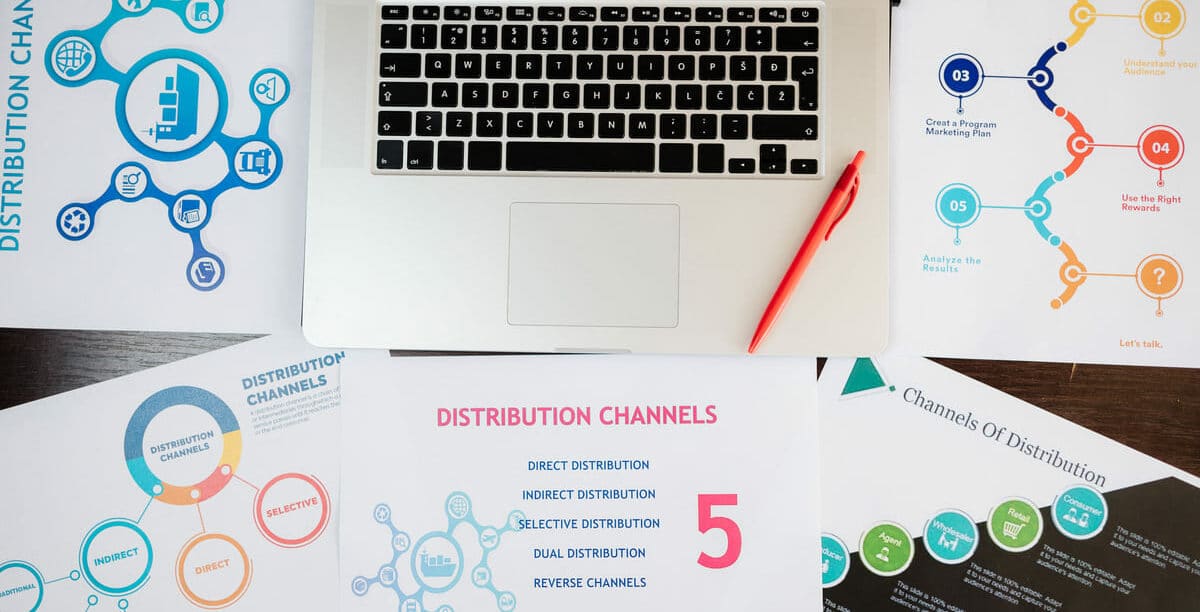Content marketing is one of the most essential and beneficial aspects of online marketing. In a nutshell, it’s creating and sharing valuable content with your target audience in order to attract and convert them into customers. However, for those who are unfamiliar with it, it can be a little confusing and overwhelming.
The secret of a successful business is its ability to adapt. To do this, you have to build a strong brand that retains your customers and has an effective content marketing strategy that can cut through the clutter. In today’s world, you won’t survive if you don’t adapt and evolve with technology. That’s why in this blog post, we’re going to teach you the step-by-step guide that provides everything you need to get started. This guide will take you through the basics of content marketing so you can start using this effective technique yourself.
What is Content Marketing?
Content marketing is a form of marketing that involves the creation and sharing of media and publishing content in order to acquire and retain customers. Content marketing allows you to build trust with your target audience, which will help you sell more products or services. The ultimate goal of content marketing is to increase customer retention and loyalty, build brand awareness, create brand advocates, and increase sales.
Content marketing is a great way to market your product or service. You can share helpful articles, videos, images, infographics and more that will help you acquire new customers in the long run. For a great content marketing strategy, content marketers must create high-quality content that can be used to promote your product or service. The content marketing institute states that “engaging content will attract new prospects, which can result in increased lead generation.
Therefore, the content strategy is a process that allows you to create and share media and publish content. This is the basis of all your content marketing efforts, whether it be through social media platforms or search engine optimization (SEO). Using content marketing is a great way to boost the visibility of your brand. The perfect content marketing examples will help you get started with your content strategy. To create a successful content marketing campaign, use perfect examples to learn new strategies and better engage with your existing customers.
Though businesses that offer web development services can find great success in online content marketing. One of the ways they can do this is by creating helpful tutorials on how to build a website. With effective content marketing examples, you can better market your product or service. Companies’ marketing strategies can include effective article marketing, video tutorials, images and infographics. You can use content marketing to establish yourself as an expert in your field.
How to create content step-by-step?
As we said above content marketing is the stairs that lead to success in the digital world. You have to take one step at a time and climb up the stairs of this staircase. And for having a solid content marketing strategy, going step-by-step is a necessity. As it’s a way to make great content and become a thought leader. Below we have mentioned each step you should consider to create valuable content and they are:

1. Define goals
In this section, you have to define clear goals before starting a content marketing strategy. It’s best if you can create a content map as well as you can consider each step as an action point and try to achieve your goal within this period.
However, setting up ROI is also one of the most important steps that should be considered already from the beginning. And only when you set up clear goals and your content is based on that strategy you can get a high ROI. If you have your own content marketing strategy, let’s say for a year or maybe two years, that’s the time when you have to take a break and then look at your goals.
According to those goals decide if it is worth going ahead with this strategy or you should stop and think of other ways how to market your business successfully in the digital world. As we have known that strategic marketing approach focused on relevant content and their goals which lead to success.
2. Find your target audience
One step before starting content creation, you should find your target audience and consider the following:
What content do they need?
How can you provide this for them?
What type of websites such as blogs, forums etc. do they use to get the information they want?
By collecting this data you will be able to create a plan how to share your content in the right channels. And for this, you have to use the relevant keywords as well as know your audience’s interests and pain points. So if you share content based on those criteria, they will visit your website more often and that way you can attract them to buy.
You should always remember that you are not writing for search engine results pages but writing for your email subscribers and people who will likely buy from your own site. Also, your blog post should not be too long because they don’t like reading long articles. Unless it is really useful for them or solves their problems in a better way. To drive profitable customer action these content marketing strategies should be implemented on all your websites.
3. Establish your KPI’s
Once you know your audience’s preferences and their needs, that’s the time when you can establish KPIs (Key Performance Indicators). In this step, you should be sure of what type of content will attract your target audience more. For example, if they are looking for videos then it is better to go with Youtube or Vimeo. Or, if they are looking for images then you should share them on Instagram and Pinterest.
Hence, your marketing team should know which type of content is working better and what type should be shared on social media platforms. And for this, you have to keep track of your analytics as well as check those numbers daily or weekly. Only then publishers can create a useful schedule for content sharing and promotion about which they can plan their editorial calendars.
The company’s own strategy developed by marketers and publishers can lead to higher conversions which keep the customers satisfied. And that’s how you can establish a successful content marketing strategy for your business in the long term.
4. Figure out content marketing channels
As you have set your goals, it’s time to brainstorm ideas for content channels. You can use different tools in order to do so. But also ask yourself the following questions in order to come up with the best possible content ideas:
What is my audience like?
Where are they located?
What time of day do they use social media?
Therefore, the various content marketing strategy examples you can use to find it. In addition, it’s not enough to have one or two channels to publish your content on. Because nowadays people want more and they want to decide which content platform will be the best for them. And that’s why you need to create a plan that includes all possible platforms you can think of in order to give your customers a chance to choose from. Content marketing institute made a very simple content marketing strategy chart in order to provide you with the best information about this issue.

The marketing tactics you can use in order to implement this step on your blog post. As well as doing keyword research is one of the most effective ways to find out which channels are really popular among your audience. On the other hand, you have to pay attention that the content doesn’t lose its value while it is transferred from one platform to another. For example, if you publish an article on Twitter about how to do something and then later you want to use this article on your blog post. You have to write the same content again, that’s why it would be better if you use each platform in order to its full potential.
5. Decide your content types
After defining your goals and strategy for your content marketing, you have to think about the different types of content. We say this because we always see that people make great efforts and spend a lot of money on creating relevant content. But they ignore the fact that there are different types of content. And it’s very important to know what type of each piece of content you are going to create.
And it’s also important that each piece of content should be based on the goals and strategies you have set up in the beginning. For example, let’s say your goal is awareness, then for this type of goal, you can focus on creating interesting videos or infographics. And for conversion, your main focus will be on creating relevant blog posts or whitepapers. This way you’ll make your content marketing strategy successful.
As we said for creating content social media strategy is also important. You should know where your targeted customer hangs around and create strategies accordingly. For example, you can think about creating interactive content on Facebook because this social media platform is mostly visited by younger people. And they like to stay connected with their friends and family there. Or maybe LinkedIn is the best place for you because here you can find your own website people who can be your potential customers. You just need to create the right content marketing efforts and set up goals first then let social media work for you.
6. Identifying and allocating resources
Once you have figured out your channels, it’s time to start working on your content. This will help you and your team to work with a list of specific tasks and prioritize what is important and something that requires more attention. Even if there is no money left for marketing, but you still want to gain more subscribers or social media followers, keep in mind that your budget should reflect your goals. So by allocating the right resources will lead you to a job well done.
Secondly, it is important to understand what your goals are and how you can achieve them. Some tools can help you figure out your main goals, like Google Analytics or CrazyEgg. These platforms will show you valuable data that can contribute insight to your customers. The written content is an important aspect of most successful companies. So be sure to continue monitoring your blog posts.
At last, try to implement new strategies, like updating your work process or changing your team’s role. Also, by doing so you can get more opportunities and most importantly you will find out what is working for you in the digital world. And then with that information create better content if required or stick to what works for you. Distributing valuable resource throughout the content generation stage is very important and you should consider this step seriously.
7. Create a Content
After having clear goals and identifying resources you should move to the next step. Create content based on your content strategy. Now, it’s up to you how many types of content you are going to make or which topics are focused on. But it is better if you focus on only two types which are evergreen content and timely relevant content.
Evergreen content is a type of content that has a longer shelf life. And it’s also called timeless. As the name suggests, evergreen content stays on your own content or blog for a long time and can get organic traffic just by updating it from time to time with relevant data.
On the other hand, timely relevant content is a type of content that is focused on current issues and problems. It can be anything from how-to articles to news articles etc. As timely content has a shorter shelf life than evergreen content so it should be created based on your resources and time availability.
However, the landing page of your content has to be clear and well optimized for getting more traffic. So, both types of content should meet the demand and need of your target audience. Because the clearly defined audience is another key factor for having a successful content strategy. And while creating content don’t forget to add your keywords research to the content you are about to create based on your strategy.

8. Distribute your content
After having quality content, it’s time to distribute them in an effective way. Make your content visible through social media platforms like Facebook, Twitter, Instagram or any other that you prefer most. Use hashtags to make your content visible but don’t abuse using hashtags. It has to be relevant and use only once in each blog post. And put some hashtags in your bio as well for each social media channel.
Hence, many content marketing strategy examples will help you to be aware of the fact that how content creation is important for your own businesses. It can get your brand ahead of all competition and get more revenue if done rightly. Additionally, in this step-by-step guide, it’s a must to promote your content on premium platforms as well. And here we have some tips that can be beneficial for you:
1. Post on Quora, Reddit and other forums relevant to your subject matter. Moreover, doing this will make your content more visible as well as build traffic through long-term engagement with people from the community.
2. Post on your social media profiles and don’t forget to add a link to your website in your bio. This way you will be able to distribute the content effectively and increase the overall awareness for your brand or business.
9. Measure your results
After distributing valuable information or your content promotion it is important to measure the results of your content. Especially, when you create a content on regular basis and if you want to make some changes to it. So, measuring the success of your content is one of the most important steps for creating an effective and fruitful content marketing strategy. You can do it by using web analytics tools like Google Analytics or Hubspot and tracking the number of viewers. And what kind of articles do they like to read and how much time do they spend on your own blog.
Additionally, content creation is not an easy task especially when it is related to the whole marketing strategy. And if you are doing it online, it will be even harder. You can always consider outsourcing content creation services by using dedicated resources that help you to get quality articles in less time and budget only.
The buyer’s journey is changing and people love to read rich and high-quality content that gives them a solution for their problems. Hence, creating quality content is a necessity when you want to become a thought leader in your industry. So, if you create content on regular basis to keep your target audience up-to-date about what’s happening to your business goals and target market. As well as, the results will come in no time.
Why content marketing is important?
Content marketing is a strategic marketing approach focused on creating valuable content to attract and retain a clearly-defined audience and, ultimately, to drive profitable customer action. Content strategy is important to ensure that the marketing articles are not just available, but valuable to your customers. It helps you focus on what content you need, how it works and who needs it. Below you find how much content marketing is important so they are:

1. Effective ROI on consistent content
Though there is a significant challenge that marketers face in seeing the results of the marketing and advertising campaigns that they do. Content marketing helps companies find the right customers for their products while showing them how to use them most effectively. This is key for getting excellent ROI. An effective content marketing strategy will help you to get the best results and add more value to your brand. The written content should always be up-to-date and provide your customers with important information. With this, you will see how the effective ROI on consistent content works for your company. And make sure your content marketing plan should be consistent with your strategies.
2. Enhance social media advertising strategy
By enhancing your social media marketing strategies, you can expand the knowledge base of your target market and build a community around your brand. As we know that social media is an important instrument for spreading information and building communities around businesses, brands and people. With a content marketing strategy, your company can create value to establish authority amongst a target audience. And it means you should also focus on making better social media content to improve your ROI. The paid advertising marketing efforts will be more efficient to your business goals when supported by better content marketing.
3. Generating more website traffic
The written content is the best guide for new customers to your website. Additionally, it can help you attract more referral traffics from other websites. The most important reason that companies are using content marketing is to generate more traffic to their sites. This will help you get better conversion rates of product or service sales on your web page. And ensure your content is useful, interesting and valuable for your customers.
Hence, successful articles can help you increase the traffic to your website by a significant factor. It includes targeting keyword research that will allow Google™ or other search engines to bring targeted visitors from subscribed newsletters or RSS feeds. For this reason, content marketing plays an important role in generating more traffic to your website.
4. Profitable in inbound marketing strategy
Although content marketing strategy can be used to promote an online business, it is also effective in promoting other businesses. Content marketing ideas are not very difficult to set up and can bring great benefits to your business. Your company does not have to use paid advertising for successful marketing. By creating valuable content that answers the questions that your prospects ask, you become confident. Then you will see how profitable the inbound marketing strategy works. The blog posts and articles that you create can also be used to advertise your business on various platforms.

5. It helps SEO effectively
The content that you publish and the links to other sites will help your SEO efforts. The more activities you do on the site, the higher it will be found in search engines like Google and Bing. Content marketing is a powerful way to distribute your message, attract links and social signals, which all contribute to better search engine rankings. Content strategy helps you to get the best SEO results and convert leads to a better position in search engines. The google search first takes the content into account and then the links. Thus, it is important to make sure that your blog posts are optimized with SEO best practices for maximum exposure in search engines.
6. Help in building relevant links
Link building is an effective way to build more trustworthy and engaging content. Content marketing works as a link magnet for your site. It attracts user-generated links that can improve your search engine rankings. With this, you will establish authority on the topics you cover with the people who need and use your products and services.
Therefore, the more relevant and popular your site is, the more likely you are to generate high-quality links. The free software that you will use can also help to optimize your content marketing blog. The brand identity in the whole content helps you in building relevant links in your blog/website. For content marketing strategy, you will need to hire a professional content writer who can make your blog great and engaging.
7. Cheaper than traditional marketing
Today, every business is online and if they need to be seen by their target customers, they have to invest in online marketing. Content marketing is relatively cheaper compared to traditional media channels like TV ads, billboards etc. It helps you get more visibility on search engines which will help your SEO rank go up. And because of that, it will get you more traffic to your site and leads for your sales team.
In traditional content marketing, you will need a video production company, graphic design agency and a copywriter. And the help of your advertising agency to create TV commercials which cost a lot of money. But with online content marketing, you don’t have all those expenses because you can create content from the comfort of your home without spending that much on hiring professionals for everything.
8. Building brand awareness
Though it is a critical challenge for every business to have effective brand awareness. Content marketing helps to break through the clutter by educating customers and prospects. One of the main benefits of a content marketing strategy is that it helps your business stay top-of-mind with consumers so they can take appropriate action at the right time when it matters most. Content marketing strategy drives the growth of your business and makes scale. The content marketing plan also helps your brand to make a great impression on potential clients and the buyer’s journey to your site.

9. Great for digital marketing solutions
Content marketing is great for digital marketing solutions because it allows your business to tell your story and build trust with potential customers. With the use of content marketing, you can create an effective strategy that will be spread across various channels (including but not limited to email, social media, etc.). This approach also builds on brand awareness, which means that you will start seeing results as early as 3 months into the process. Content promotion is another way that content strategy helps you because it allows your business to tell your story in an authentic and valuable way.
How many types of content marketing?
Content marketing is the basic need of every business. Depending on your industry and product, you can create different types of content for your target consumers. Content Marketing is getting attention from all markets because it’s free. And can be distributed through various channels which makes it very effective to attract new customers. There are many types of content marketing and below we have mentioned some famous ones:
1. Blog
Blogging is a great way to share valuable information with your target audience, who are the potential customers for your business. For content marketing strategy blog is important because it does not hold the users but encourages them to continue reading. Blog content is a great way to build your brand and drive traffic to your website. A well-organized blog strategy keeps you focused on the keywords and topics that interest your target audience. Long-form content is the perfect way to tackle pain points, answer questions, and establish authority in your niche.
Though high-quality, optimized blog posts can also perform well in search engines, giving your SEO a boost. Long-form content is a more perennial type of content marketing than many other formats. So the content you post today can continue to generate traffic and leads for years to come. Another benefit of blogging is that it emphasizes the personality of your brand. Whether your brand is innovative, smart, or fun, blogging gives you plenty of room to show off your unique personality.
2. Webinars
For an effective content marketing strategy webinars are also important. Having live webinars can be a great way to generate leads for your business. Webinars are a content strategy tool that can help educate your prospects and customers to help them better understand a variety of topics, like how to use your product. Expert insight on a specific topic, how to tackle a particular problem, etc.
Another great advantage of webinars is that they allow live interaction between the presenter and the audience. Viewers can ask questions and the presenter can answer them in real-time, helping to create a more personal connection than other, more static forms of content.

3. Podcasts
Podcasting is becoming an effective form of content marketing and branding. One of its greatest benefits is that it enables you to provide long-form, high-value information without investing a lot of time or effort. It allows you to share your experience and stories directly with your audience. It helps you build relationships with your prospects by connecting with them on a more personal level. For content strategy podcasting is a great way to engage with your existing customers and establish yourself as an authority figure in your given industry.
4. Visual content marketing
Visual content marketing is a new marketing strategy that embraces the principle of creating and sharing visual blogs that are relevant to your target group in order to attract interesting, attractive and qualified leads. This content marketing plan also includes the use of visual content such as videos, animations and images.
In today’s digital marketing world, you need to pay attention to the ranking of your visuals, how many people follow you, how many people watch your videos or read your blogs. Because many people prefer ways to save time for reading, shopping or traveling before taking any action. Visual content strategy is a great way to attract your target audience have people find out about new information through your visuals and engage with them.
5. Video content marketing
Video content marketing is an extremely powerful tool that, if created correctly, can allow you to reach your target audience in a way like never before. Using this type of content strategy allows you to create highly customizable videos that will resonate with people on an emotional level and encourage them to take action. For example, design companies can benefit from AR video marketing, which provides a digital model of what you see using a smartphone. You can conduct interviews; share new developments about your industry; and showcase your talent in a unique, entertaining way.
6. Infographics
Infographics allow you to quickly and clearly present significant amounts of information, including business, or SEO statistics, and more. They can act as standalone pieces of content that can be shared on social media. Alternatively, they can serve as a supplement to written material, such as a blog post or whitepaper. In addition to being visually appealing, infographics are well suited to social media marketing efforts and are especially shared with interesting people. The more people insert the infographic, the more backlinks you will get, which will benefit your SEO. Therefore, the content marketing strategy should focus on infographics that are shareable.
7. Social Media posts
Most marketers use social media for content marketing, which means it is a great strategy that can generate a lot of traffic. Facebook and Instagram are two of the most powerful platforms companies can use to reach large audiences and share visual content with them. The main advantage of social networks is direct engagement with your audience. It’s a real-time feedback loop that helps you understand what your audience cares about and engages in direct conversations with them to dig deeper.
For some brands, social platforms can also be used to guide their audience to sales, promotions, and events. Additionally, social marketing gives you a direct way to distribute your content to your audience and express your brand personality in the process. For a great content marketing strategy, social media posts are the best option.

8. Email marketing
Email marketing is one of the best ways to communicate with your customers and prospects, while also providing valuable content. The key to successful email marketing is to send emails on a regular basis that give people something they can’t get anywhere else. Email marketing is sending commercial emails to a list of contacts who have given their explicit permission to receive email communications from you. Modern email marketing has moved away from one-size-fits-all mass emails and instead focuses on consent, segmentation, and personalization. It may sound slow, but marketing automation does the heavy lifting for you.
9. White papers
White papers are one of the most popular examples of this strategy because they’re useful for both parties. White papers and e-books are a great way to build thought leadership, gain credibility in your industry, generate leads, and position yourself as an expert. They are generally longer and more technical than blog posts. This allows you to explore a particular topic in-depth and share more detailed information beyond what you can normally do in a blog post. With white papers and e-books, it’s important to share quality content that delivers expected value while taking the time to download your content.
10. Case studies
As you create more content to support your brand, be sure to include case studies where appropriate. These are real examples of how different people have had positive experiences with your product or service. By publishing case studies, you can provide proof that the problem they are having is being addressed by other companies or organizations. Case studies and success stories are great examples of conversion-driven content marketing. They are an extremely effective way to generate leads at the bottom of the conversion funnel. Case studies are especially important for high-cost, high-value products and services.

Tips we should know
Generally, for your new blog posts here are some tips you should consider before implementing your marketing strategy goals:
- Read your blog post at least three times before publishing
- Be sure to proofread the content, check for grammar and spelling mistakes. Remember you are building authority in your niche, don’t make avoidable mistakes.
- Make sure that the title is catchy and to the point; this should draw the attention of both readers and search engines.
- Add pictures or viral videos. Visuals are always very engaging and people love to watch (and share). Adding a viral video can increase traffic to your blog and social media channels.
- Add a CTA (Call-to-Action) at the end of your blog posts
- Be consistent, update your blog daily or weekly with new content. Consistency is key in building up an audience and it will also contribute to increasing ranking on search engines as well.
- Make sure that your meta tags are correct. These do not need to be over-complicated, but they should contain the keywords you hope to rank for in Google.
- Use social media to promote your blog posts, a great infographic from Hubspot about Influencer marketing on Twitter to help you increase traffic.
- Promote your content through email marketing to your subscriber list, don’t spam but invite them to visit your blog and provide value. This way they will recognize the effort you put in each time you publish a new piece of content.
- Use keywords to optimize your blog posts: use them in the title, subtitle and throughout the article.
- Make sure that each blog post is linkable by using plenty of social media share buttons and linking back to your website, where appropriate.
- After you publish a new post be sure to send it out via email newsletters, instant messenger applications and other social media platforms.
- Finally, don’t forget to monitor your results! What worked? What didn’t? Use this information to help guide you through the process of creating future blog posts. Also keep checking Google Analytics for info about which posts are ranking organically, traffic history and where your audience is coming from.
The Conclusion
Content marketing is a successful strategy for companies to use. Creating engaging content and providing value to your customers can be complicated. There are many different aspects of content marketing, including publishing written blog posts, infographics, videos, etc. And that makes it hard for marketers to know where to start when they want to create new pieces of content or update old ones. The good news is that there are some basic steps you can follow to make the process easier on yourself. With the step-by-step process laid out for you, it’s easy to see how content marketing can help your business grow.
Whether through social media or blogging, there are many ways that your company could start building a solid online presence and increase sales. So, implementing these tips will help you increase your customer base and maximize profits by providing valuable information relevant to their needs, interests, and desires. We hope this article gave you the tools needed to create an effective content marketing strategy for your business or organization. If you have any queries regarding the above context, share a comment section below.
FAQs
What are long-tail keywords in content writing?
Long-tail keywords are those that describe the content of your article, not just its title. For example, "how to lose weight" is a short-tail keyword because it only describes what's in the headline. But "7 ways to lose weight," while still pretty specific and probably not very helpful to most people looking for information on how to lose weight fast or easily. It would be considered long keywords since they go into more detail about one aspect of losing weight.
Long-tail keywords are important for content marketing because they are typically more specific. Therefore, therefore have a higher potential to rank in SERPs than general keywords. Additionally, keywords tend to attract less competition from other websites. And making it easier to rank high in SERPs for them. This makes them an important tool for businesses that want to drive traffic to their websites through organic engine results.
Which is the successful content marketing strategy?
A successful content marketing strategy is one that aligns with your business goals and the expectations of your audience. There are many factors to consider when developing a content marketing strategy. But it all starts with identifying what you want to achieve. Do you want to increase brand awareness? How does it convert leads? Sell products or services?
Once you know this, it's easier to pinpoint which channels will be best for reaching your goals. For example, if you're looking for ways to generate leads, LinkedIn might be better than Facebook. Because it has more professional profiles and tends to attract higher-quality visitors (those who are likely interested in buying). If selling products or services is your goal, then YouTube may be better than Instagram because viewers tend not only to watch videos but also take action.
How does a content marketing campaign charge?
A content marketing campaign charges based on how much work is put into it. For example, if you write one article for a client and they want another article written. But don't want to pay the price we charge per word/article, then that would be considered "work" and therefore would cost money.
If your company has a lot of employees who are good at writing articles or blog posts. Then this could be an effective way to generate revenue without having too many overhead costs associated with maintaining an office or staff members.
The cost of a content marketing campaign will vary based on the size and scope of your desired outcome. The more customers you want to reach, the higher the price tag you'll need. The bigger budget that's available for this type of advertising, the more creative and engaging an experience your brand can provide its audience with at no additional expense. This includes things like video production or animation which may not be feasible within smaller budgets but are still possible with larger investments in time and resources.
What is a strategic approach in content marketing?
A content strategy approach is a plan for creating, curating valuable and relevant digital or offline content to attract specific audiences. It includes the research of your target audience's needs, what they are interested in. Where you can find them online as well as how you will reach out to them with quality information that they would be interested in receiving.
Therefore, the strategy also involves using various tactics such as blogging, infographics or videos depending on your desired goal. Which may change from time to time according to the market conditions at that point in time. A strategic approach to content marketing will help you reach your target audience and generate leads and sales for your business. It's also important to have a distribution plan in place that identifies where your target audience hangs out online. And what channels you will use to share your content with them. And lastly, you need to set measurable goals so that you can track and measure your progress over time.





